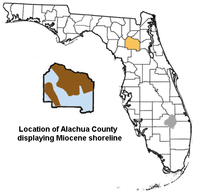Haile Quarry site

Alachua County, Florida and Miocene shoreline based on the Florida Geologic Survey.

Florida during the Miocene

Florida during the Pleistocene
The Haile Quarry or Haile sites are an Early Miocene and Pleistocene assemblage of vertebrate fossils located in the Haile quarries, Alachua County, northern Florida. The assemblage was discovered during phosphate mining, which began in the late 1940s.[1] Haile sites are found in the Alachua Formation. Two sites within the Ocala Limestone yielded Upper Eocene Valvatida (sea stars) and mollusks.
University of Florida and Florida Museum of Natural History paleontologists numbered the Haile fossil sites with Arabic and Roman numbers and letters in order to define locations more distinctly. UF scientists used Roman numbering and the FLMNH scientists used Arabic.
Numbered Haile sites
- V/XIXA aka Haile 5A, 19A (FLMNH repository)
- 5B Miocene
- 6A.
- 7C.
- 12B.
- XVA aka 15A.
- 16A.
- 21A.
- ID.
- VIIA.
- VIIIA.
- XIB.
- XIIIA.
- XIIIB.
- XIVA.
- XIXD.
- IVB.
Late Pleistocene Haile sites: 7C, 15A, 16A, and 21A.
Fish
- Carcharodon auriculatus
Amphibians/Reptiles
- Bufo (toad)
- Coluber constrictor (Eastern Racer)
- Emydidae (turtle)
- †Gavialosuchus (Crocodile)
- Hesperotestudo crassiscutata (turtle)
- Deirochelys (Chicken Turtle)
- Micrurus fulvius (Coral snake)
- Ranidae (True Frog)
- †Sphenodontia (lizard)
- Terrapene carolina (Eastern Box Turtle)
Birds
- Anatidae indet (duck)
- †Aizenogyps toomeyae (Condor)
- Anhinga grande (Snakebird)
- Ceryle torquata (Belted Kingfisher)
- Motmotidae (Motmot)
- Phalacrocorax (Cormorant)
Mammals
Carnivores
- Procyon (raccoon)
Canidae
- †Borophagus (ancestor of dogs)
- Canidae
- †Canis armbrusteri (Armbruster's wolf)
- †Canis edwardii (Edward's wolf)
- †Canis dirus (Dire wolf)
- Canis rufus (Red wolf)
- †Epicyon haydeni (ancestor of dogs)
- Urocyon cinereoargenteus (fox)
Bears
- †Arctodus pristinus (Short-faced Bear)
- †Tremarctos floridanus (Florida Cave Bear)
Feliformia
- †Homotherium (Saber-toothed cat)
- Lynx rufus (Bobcat)
- †Panthera onca (Jaguar)
- †Smilodon gracilis (Saber-toothed cat)
Mustelids
- Conepatus leuconotus (Hog-nosed skunk)
- Mephitis mephitis (Striped Skunk)
- Mustela frenata (Long-tailed Weasel)
- †Satherium piscinarium (North American Giant Otter)
- Spilogale putorius (Eastern Spotted Skunk)
- Trigonictis cookii (Galictis)
Herbivores
Even-toed ungulates
- †Aepycamelus (Camel)
- Bison latifrons (Bison)
- †Camelidae (Camel)
- †Gelocidae (early horse-type ungulate)
- †Hemiauchenia macrocephala (Llama)
- †Mylohyus floridanus (Peccary)
- †Odocoileus virginianus (Deer)
- †Palaeolama mirifica (Llama)
- †Platygonus, P. compressus, P. vetus (Peccary)[2]
- †Yumaceras hamiltoni (early horse-type ungulate)
Odd-toed ungulates
- †Aphelops (rhinoceros)
- †Calippus, C. elachistus, C. hondurensis (horse)
- †Dolichohippus (horse)
- †Equus sp,. E. fraternus, E. leidyi (horse)
- †Tapirus, T. haysii (tapir)
- †Dasypus bellus (armadillo)
- †Hippotherium, H. ingenuum, H. plicatile (horse)
- †Nannippus, N. peninsulatus, N. westoni (horse)
- †Neohipparion trampasense (horse)
- †Protohippus gidleyi (horse)
- †Pseudhipparion skinneri (horse)
- †Teleoceras, T. proterum (rhinoceros)
Proboscidea
- †Cuvieronius tropicus (early elephant)
- †Gomphotheriidae (elephant)
Xenarthra
- Dasypus bellus (armadillo)
- †Eremotherium, E. eomigrans (giant sloth)
- †Glossotherium chapadmalense (giant ground sloth)
- †Glyptotherium arizonae (armadillo-like)
- †Holmesina floridanus, H. olmesina, H. septentrionalis (armadillo)
- †Pachyarmatherium leiseyi (armadillo-like)
- †Megalonyx, M. leptostomus, M. wheatlyi (giant ground sloth)
- †Paramylodon harlani (giant ground sloth)
- †Pliometanastes (giant ground sloth)
Bats
- Myotis austroriparius (Southeastern Bat)
- Desmodus, D. archaeodaptes, D. stocki (Common Vampire Bat)
- Lasiurus intermedius (Northern Yellow Bat)
- Pipistrellus subflavus (Eastern Pipistrelle)
Rodents
- Atopomys texensis
- Castor canadensis (beaver)
- Cryptopterus webbi (squirrel)
- Didelphis virginiana (Virginia Opossum)
- Erethizon, E. dorsatum, E. poyeri (porcupine)
- Geomys pinetis (pocket gopher)
- Microtus australis (vole)
- Microtus pinetorum (Woodland Vole)
- †Mylagaulus kinseyi (Horned Gopher)
- †Neochoerus, N. aesopi (Capybara)
- Neofiber alleni (Round-Tailed Muskrat)
- Neotoma (Packrat)
- Neotoma floridana (Florida Woodrat)
- Ochrotomys nuttalli (Golden Mouse)
- Orthogeomys propinetis (gopher)
- Oryzomys palustris (Marsh Rice Rat)
- Peromyscus (Deer Mouse)
- Peromyscus gossypinus (Cotton Mouse)
- Peromyscus polionotus (Oldfield mouse)
- Podomys floridana, P. gossypinus (Florida mouse)
- Pronotolagus (rabbit)
- Reithrodontomys H. humulis (harvest mouse)
- Sciurus carolinensis (Eastern Grey Squirrel)
- Sigmodon, S. bakeri, S. hispidus, S. libitinus, S. minor (rat)
- Spermophilus (Ground Squirrel)
- Sylvilagus (Cottontail Rabbit), S. webbi
- Sylvilagus floridanus (Eastern Cottontail)
- Synaptomys, S. australis, S. morgani (lemming)
- Zapodidae (jumping mice)
Moles and Shrews
- Blarina (American Short-Tailed Shrew)
- Blarina carolinensis (Southern Short-Tailed Shrew)
- Cryptotis parva (North American Least Shrew)
- Scalopus aquaticus (Eastern Mole)
- Sorex longirostris (Southeastern Shrew)
Unclassified mammal
- Petauria
Sea mammals
- Cynthiacetus maxwelli. (possibly pre-peninsular) ~37.2—33.9 Mya.[3]
- Zygorhiza
References
- ↑ Simpson, G. G. 1930. Tertiary land mammals of Florida. Bulletin of the American Museum of Natural History, 49:149-211.
- ↑ Florida Museum of Natural History: Peccary
- ↑ Reference: G. S. Morgan. 1978. The fossil whales of Florida. The Plaster Jacket 29:1-20
This article is issued from Wikipedia - version of the 4/7/2015. The text is available under the Creative Commons Attribution/Share Alike but additional terms may apply for the media files.